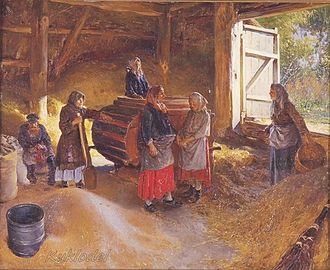Barn





Barn is a structure primarily used for the storage and housing of agricultural equipment, livestock, and crops. The term "barn" often refers to buildings that are used in farming to store hay, grain, and other agricultural products, as well as to house animals such as cattle, horses, and sheep. Barns are an essential part of rural landscapes and have various architectural styles that vary depending on their purpose, the region, and the period in which they were built.
History[edit]
The history of barns traces back to the agricultural revolution, where the need for permanent structures to store surplus crops became evident. Early barns were simple structures made from available materials such as wood, stone, and thatch. As farming practices evolved, so did barn designs, adapting to the needs of different agricultural practices, climates, and cultures. In Europe, the medieval period saw the construction of large tithe barns used for storing rents and tithes in the form of crops. In North America, barns were integral to the settlement and development of agricultural lands, with designs such as the English barn and the New England barn becoming common.
Design and Structure[edit]
The design and structure of barns vary widely. Traditional barns were often constructed with a post-and-beam construction method, which allowed for large, open spaces free of internal columns. This design was particularly useful for housing livestock and storing hay and equipment. The roofs could be gabled, gambrel, or hip-roofed, depending on the style and function of the barn.
Modern barns may be constructed with a variety of materials, including metal, concrete, and engineered wood, and may incorporate technology such as automated feeding systems and climate control. The design of a barn is heavily influenced by its intended use, with dairy barns, for example, having a different layout and features compared to barns used for housing poultry.
Cultural Significance[edit]
Barns hold significant cultural and historical value in many societies. They are symbols of agricultural heritage and rural life. In some cultures, barns are the sites of social gatherings and events, such as barn dances and weddings. The preservation of historic barns is a concern for heritage conservationists, as these structures are often considered to be important landmarks that reflect the agricultural practices, architectural styles, and history of a region.
Types of Barns[edit]
There are several types of barns, each designed for specific functions. Some of the most common include:
- Dairy Barns: Designed for milking dairy cattle. They often have a central aisle with stalls for the cattle and equipment for milking. - Horse Barns: Used for housing horses. They may include features such as individual stalls, a tack room, and a wash bay. - Pole Barns: Constructed with poles as the main support structure. They are versatile and can be used for a variety of purposes, including as workshops or storage sheds. - Tobacco Barns: Used for drying tobacco leaves. They are typically found in regions where tobacco farming is prevalent. - Bank Barns: Built into a hillside, allowing for two levels to be accessed from the ground. This design is efficient for handling livestock and storing equipment.
Conclusion[edit]
Barns are more than just functional agricultural buildings; they are a testament to the ingenuity and adaptability of farmers throughout history. They reflect the agricultural practices, architectural styles, and cultural values of the societies that built them. As such, barns are an important part of our agricultural heritage and continue to serve as a vital component of farming operations around the world.

This article is a architecture-related stub. You can help WikiMD by expanding it!
Ad. Transform your life with W8MD's Budget GLP-1 injections from $75


W8MD offers a medical weight loss program to lose weight in Philadelphia. Our physician-supervised medical weight loss provides:
- Weight loss injections in NYC (generic and brand names):
- Zepbound / Mounjaro, Wegovy / Ozempic, Saxenda
- Most insurances accepted or discounted self-pay rates. We will obtain insurance prior authorizations if needed.
- Generic GLP1 weight loss injections from $75 for the starting dose.
- Also offer prescription weight loss medications including Phentermine, Qsymia, Diethylpropion, Contrave etc.
NYC weight loss doctor appointmentsNYC weight loss doctor appointments
Start your NYC weight loss journey today at our NYC medical weight loss and Philadelphia medical weight loss clinics.
- Call 718-946-5500 to lose weight in NYC or for medical weight loss in Philadelphia 215-676-2334.
- Tags:NYC medical weight loss, Philadelphia lose weight Zepbound NYC, Budget GLP1 weight loss injections, Wegovy Philadelphia, Wegovy NYC, Philadelphia medical weight loss, Brookly weight loss and Wegovy NYC
|
WikiMD's Wellness Encyclopedia |
| Let Food Be Thy Medicine Medicine Thy Food - Hippocrates |
Medical Disclaimer: WikiMD is not a substitute for professional medical advice. The information on WikiMD is provided as an information resource only, may be incorrect, outdated or misleading, and is not to be used or relied on for any diagnostic or treatment purposes. Please consult your health care provider before making any healthcare decisions or for guidance about a specific medical condition. WikiMD expressly disclaims responsibility, and shall have no liability, for any damages, loss, injury, or liability whatsoever suffered as a result of your reliance on the information contained in this site. By visiting this site you agree to the foregoing terms and conditions, which may from time to time be changed or supplemented by WikiMD. If you do not agree to the foregoing terms and conditions, you should not enter or use this site. See full disclaimer.
Credits:Most images are courtesy of Wikimedia commons, and templates, categories Wikipedia, licensed under CC BY SA or similar.
Translate this page: - East Asian
中文,
日本,
한국어,
South Asian
हिन्दी,
தமிழ்,
తెలుగు,
Urdu,
ಕನ್ನಡ,
Southeast Asian
Indonesian,
Vietnamese,
Thai,
မြန်မာဘာသာ,
বাংলা
European
español,
Deutsch,
français,
Greek,
português do Brasil,
polski,
română,
русский,
Nederlands,
norsk,
svenska,
suomi,
Italian
Middle Eastern & African
عربى,
Turkish,
Persian,
Hebrew,
Afrikaans,
isiZulu,
Kiswahili,
Other
Bulgarian,
Hungarian,
Czech,
Swedish,
മലയാളം,
मराठी,
ਪੰਜਾਬੀ,
ગુજરાતી,
Portuguese,
Ukrainian